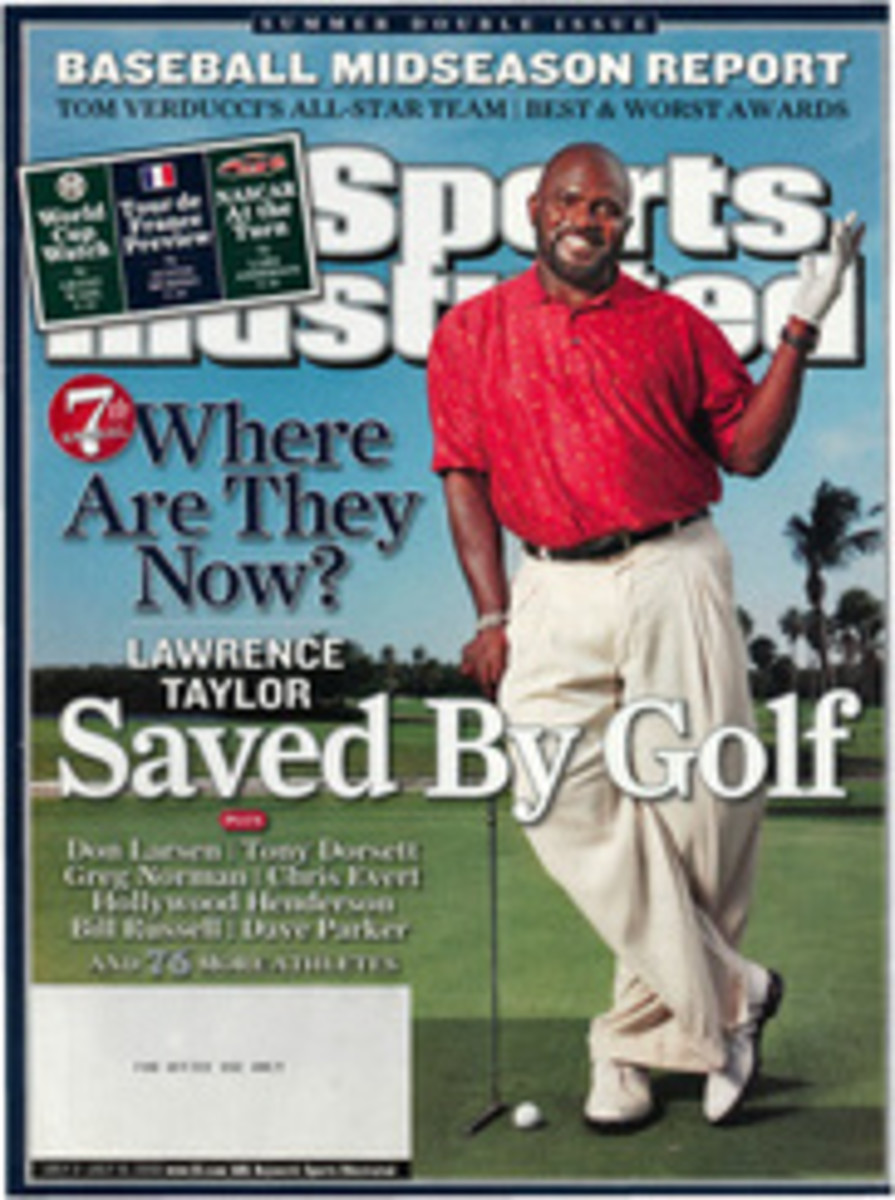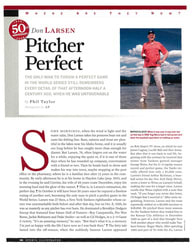
Year of the Rookie
One day in lateMay, Matt Kemp was in Huntsville, Ala., preparing to play outfield for theDouble A Jacksonville Suns. The next day he was in Washington, D.C., making hisbig league debut for the Los Angeles Dodgers. The difficulty in adapting tosuch a swift move was immediately and painfully obvious. Kemp misplayed a ballin centerfield and whiffed three times on sliders from the Nationals' RamonOrtiz, a rather pedestrian righthander. Dodgers general manager Ned Collettiwould later say that Kemp, 21, who only three years ago was playing high schoolbaseball and being recruited to play basketball at Oklahoma, "lookedtotally overmatched." ¶ Kemp, after all, never saw such a promotion coming.His first reaction upon hearing he was being called up was excitement--aboutthe idea of playing in Triple A. After Kemp's unseemly debut, Colletti walkedinto the office of manager Grady Little and said, "Well, we're going tolearn a lot about Matt Kemp real quickly after that." ¶ Here is what theDodgers had learned about the 6'2", 230-pound Kemp after his next 64 atbats, during which he hit .391 and blasted seven home runs: The guy has theall-around game of Joe DiMaggio with the instant impact of Chipper Jones(according to Little), the size and athleticism of Dave Parker (say manyscouts) and the talent of Manny Ramirez but with a better glove (in theestimation of teammate Sandy Alomar Jr.).
"At this stageof a player's career it's about making adjustments, and Matt's been makingthem," Colletti says of Kemp, who at week's end was hitting .324."Young players often succeed at first because of adrenaline and the newnessof it all. But as Grady says, at this level the games do come fast. And advancescouts are very good at what they do. You learn quickly what scouts think canbe exploited in your game.
"So soon afterthat initial rush the great unknown about a player is, Can he adjust? Mattlooks like he's here to stay."
As the major leagueseason reaches the halfway point this week, Kemp is the most prominent playeron the most prominent team among those following an industry trend in whichcontenders are counting on rookies in key roles to help them get to thepostseason. In addition to Kemp the Dodgers are relying on first-year bigleaguers at catcher (Russ Martin), in the rotation (Chad Billingsley), as asetup reliever (Jonathan Broxton), at closer (Takashi Saito) and as a platoonoutfielder (Andre Ethier).
The infusion ofinexperienced players made a surprising first half even more unpredictable.Seventeen of the 30 clubs were within five games of a playoff spot throughSunday, including four teams that haven't been to the postseason in at least 10years (Cincinnati, Colorado, Detroit and Toronto). Noticeably absent from the17 were perennial division champ Atlanta (the last time the Braves missed theplayoffs was 1990) and Cleveland, two teams that have taken a step backwardafter infusing their clubs with youth last year.
The Dodgers and theTigers, teams that each lost 91 games in 2005, are strong contenders in partbecause of impact rookies. Detroit starting pitchers Justin Verlander and ZachMiner and reliever Joel Zumaya got off to a combined 16-6 start.
The Texas Rangers,another losing team last year (79-83), are battling the Oakland A's for the ALWest lead with rookies John Rheinecker (3-1, 3.57 ERA) in the rotation and IanKinsler (.287 batting average) at second base. The Milwaukee Brewers, in searchof their first winning season since 1992, have wild-card aspirations and astrong Rookie of the Year candidate in first baseman Prince Fielder (.287, 14homers, 40 RBIs).
Even thelarge-market, free-spending clubs are finding room for rookies. The New YorkYankees, for instance, upon losing veteran corner outfielders Hideki Matsui andGary Sheffield for most of the season to injuries, have given rookie MelkyCabrera (.250) extended playing time. And fellow AL East superpower Boston hasfour rookies on its pitching staff: recently promoted setup men Manny Delcarmenand Craig Hansen, starting pitcher Jon Lester (2-0, 2.76) and closer JonathanPapelbon (23 saves, 0.24), who has been near perfect.
If you think thefirst half of the season was hard to predict, just wait for the second half.That's because most rookies have never played a six-month season. Not only willyoung players face the physical challenge of a longer season, but also somewill feel the pressure of a major league pennant race. "To be able tosurvive takes the right balance of young players and veterans, especially asyou get closer to October," Indians G.M. Mark Shapiro says. "TheDodgers have veterans, guys like Kenny Lofton, Jeff Kent and Nomar Garciaparra,who can take some of that pressure off the young players."
One NL G.M.,however, says youth will be especially important this season, the first inwhich amphetamines have been banned in the big leagues. "I expect if thereis an effect with amphetamines out of the game, it will show up in the secondhalf," he says. "And the players who will have more trouble keepingtheir bodies ready to play are the older players."
As is the caseevery year, injuries, like those to Matsui and Sheffield, have createdopportunities for young players. Kemp, too, was summoned because outfieldersLofton and J.D. Drew, though not placed on the disabled list, were banged up.But according to general managers and other team executives, a diminishedinventory of available, desirable veteran players has created an environmentthat encourages contenders to give young players their shots. That environmenthas been driven by several factors:
•Fully-phased-inrevenue sharing
Low-revenue teams no longer are forced to dump contracts as frequently as theyonce were. The flow of money from large-revenue teams to low-revenue teams, forinstance, has helped facilitate contract extensions for Johan Santana inMinnesota, Ben Sheets in Milwaukee, C.C. Sabathia in Cleveland and Roy Halladayin Toronto, signings that restrict the market for the big spenders who inrecent years have picked off aces such as Curt Schilling, Tim Hudson, MarkMulder and Randy Johnson.
"You can make acase that the most valuable commodity in the game today is the homegrownace," Boston G.M. Theo Epstein says. "They're just not getting on themarket." Adds Colletti, "I don't hear anybody calling and saying, 'Wecan't afford this guy. We have to move him.' I don't hear thatanymore."
•Weak free-agentclasses
Few stars were on the market last winter, and this year's crop may not be muchbetter, with Oakland lefthander Barry Zito perhaps the headliner. "Witholder players you like having a better idea of what you're going to get,"Colletti says, "but teams are asking why they should pay a premium for aguy who may not be a premium player. You start to ask, What's wrong with givinga young kid a chance?"
The free-agentmarket has been thinned not only by revenue sharing, but also by a trend towardlonger contracts. Says Milwaukee G.M. Doug Melvin, "What were two- andthree-year deals have become four- and five-year deals, so you don't get thefree agents turning over as often."
•A weak trademarket
The Marlins are saying they will keep pitcher Dontrelle Willis; the Brewersaren't ready to move leftfielder Carlos Lee; and the Nationals, capitalizing ona sellers' market, can hold out for a high price for leftfielder AlfonsoSoriano. The pickings beyond that are slim. "The inventory of availableplayers is small," Colletti says.
•A down cycle inthe development of pitchers has finally turned upward
No starting pitcher has won the AL Rookie of the Year award since Dave Righettiof the Yankees did in 1981, yet Verlander (9-4, 3.39) and the dazzlingFrancisco Liriano of Minnesota (7-1, 2.17) should contend for the honor withPapelbon. Meanwhile, Lester, Rheinecker, Casey Janssen of the Blue Jays (5-6,4.76), Jamie Shields of the Devil Rays (4-0, 3.00), Jeremy Sowers of theIndians (who lost his major league debut on Sunday after going 9-1 with a 1.39ERA in Triple A) and Jered Weaver of the Angels (4-0, 1.37 before being sentback to Triple A) make up the wave of top young pitchers to hit the league. Anddon't forget 20-year-old Felix Hernandez of Seattle (7-7, 5.10), already in hissecond season.
"Liriano,Verlander and Hernandez are a cut above everybody else," one AL G.M. says."They have special stuff."
The crop of NLrookie starting pitchers, though not as impressive, still features the Dodgers'Billingsley (no decisions in his first two starts), Matt Cain of San Francisco(6-6, 5.20), Cole Hamels of Philadelphia (1-3, 4.41), Josh Johnson of Florida(6-4, 2.01) and Anthony Reyes of St. Louis (1-1, 1.80).
How these youngpitchers hold up in the second half of the season figures to influence, if notoutright decide, the pennant races. One AL G.M., for instance, calledVerlander's health and effectiveness the key to the Tigers' chances. Therighthander threw 130 total innings last season, his first year in pro ball,but is on pace to exceed 200 this year. Manager Jim Leyland said heoccasionally will give Verlander an extra day of rest between second-halfstarts.
The Red Sox,meanwhile, were so careful to limit Lester's workload in anticipation of havinghim in their rotation in the second half that they kept him on a 60-pitch limitthrough his first four starts in Triple A. "He wasn't happy, and he wasn'tpitching particularly well," Epstein says. "It's hard to keep yoursecondary pitches sharp when you're only going three, four innings. But I don'tthink you're going to win a big league pennant race on a 45-degree night inApril in Pawtucket. However Lester does [in the second half], I don't seeworkload being a problem."
What the Tigers areasking of Verlander and the Giants of Cain--both were on their respectiveclub's Opening Day rosters--is one of the most difficult assignments inbaseball: to spend the entire big league season in the rotation of a playoffteam as a rookie. Of the 88 postseason teams in the wild-card era only one hada rookie who won more than 14 games (the 2001 Indians with Sabathia), and onlyone made it to the World Series with a rookie throwing the minimum 162 inningsto qualify for the ERA title (the '02 Giants with Ryan Jensen, who, fatigued atthe finish, was dropped from their postseason roster).
Indeed, winning theWorld Series with rookie starting pitchers or rookie every-day position playersis so rare (excluding experienced international free agents) that only fourteams in the wild-card era have done so: the 2003 Marlins (with Willis, anearly-season call-up, and outfielder Miguel Cabrera), the '02 Angels(righthander John Lackey, a midseason call-up), the 1996 Yankees (shortstopDerek Jeter) and the '95 Braves (third baseman Chipper Jones). The rarity ofsuch precedents, though, is being challenged in this, the Year of the Rookie.It is a year in which many clubs' World Series aspirations have a commonlyshared notation: No experience necessary.
SI.COM
Read more from Tom Verducci every Tuesday and Wednesdayat SI.com/baseball.
PHOTO
Photograph by Chuck Solomon
QUICK STUDIES A late-May call-up, Kemp belted seven homers in his first 15 big league games; Zumaya (opposite) struck out 46 batters in his first 37 innings.
PHOTO
LEON HALIP/WIREIMAGE.COM
[See caption above.]
PHOTO
DAVID E. KLUTHO (FIELDER)
GROWING PAINS Fielder started the season 2 for 14 but quickly started flirting with .300.
PHOTO
GAIL OSKIN/WIREIMAGE.COM (LESTER)
HANDLE WITH CARE Boston limited Lester to 60 pitches in his first four Triple A starts so he'd be fresh for the big club.

